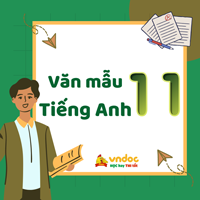Tiếng Anh 11 Global Success Unit 1 Communication and Culture/ CLIL
Tiếng Anh 11 Unit 1 Communication and Culture/ CLIL
Nằm trong bộ tài liệu Giải tiếng Anh 11 Kết nối tri thức theo từng Unit, Soạn tiếng Anh 11 Unit 1 A long and healthy life Communication and Culture/ CLIL giúp các em chuẩn bị bài tập SGK tiếng Anh hiệu quả.
Tiếng Anh 11 Global Success Unit 1 Communication and Culture/ CLIL
Bản quyền thuộc về VnDoc nghiêm cấm mọi hành vi sao chép vì mục đích thương mại
Everyday English
Offering help and responding
(Đề nghị giúp đỡ và phản hồi)
1. Listen and complete the conversation with the expressions in the box. Then practise it in pairs.
(Nghe và hoàn thành đoạn hội thoại với các cách diễn đạt trong khung. Sau đó thực hành nó theo cặp.)
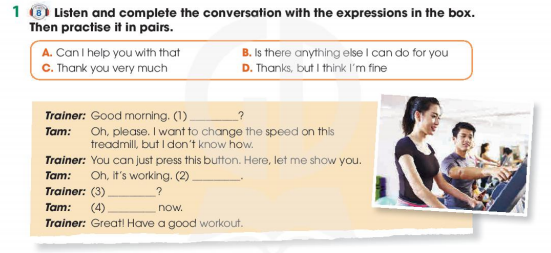
Gợi ý đáp án
1. A | 2. C | 3. B | 4. D |
Lời giải chi tiết
Trainer: Good morning. (1) Can I help you with that?
(Huấn luyện viên: Chào buổi sáng. Tôi có thể giúp bạn với điều đó?)
Tam: Oh, please. I want to change the speed on this treadmill but I don't know how.
(Tâm: Ồ, làm ơn. Tôi muốn thay đổi tốc độ trên máy chạy bộ này nhưng tôi không biết làm thế nào.)
Trainer: You can just press this button. Here, let me show you.
(Huấn luyện viên: Bạn có thể chỉ cần nhấn nút này. Đây, để tôi chỉ cho bạn.)
Tam: Oh it's working. (2) Thank you very much.
(Tâm: Ồ nó đang hoạt động. Cảm ơn rất nhiều.)
Trainer: (3) Is there anything else I can do for you?
(Huấn luyện viên: Tôi có thể làm gì khác cho bạn không?)
Tam: (4) Thanks, but I think I'm fine now.
(Tâm: Cảm ơn, nhưng tôi nghĩ bây giờ tôi ổn rồi.)
Trainer: Great! Have a good workout.
(Huấn luyện viên: Tuyệt vời! Có một tập luyện tốt.)
Everyday English
2. Work in pairs. Use the model in 1 to make similar conversations for these situations. One of you is Student A, the other is Student B. Use the expressions below to help you.
(Làm việc theo cặp. Sử dụng mô hình trong phần 1 để tạo các hội thoại tương tự cho các tình huống này. Một trong số các bạn là Học sinh A, người kia là Học sinh B. Sử dụng các biểu thức dưới đây để giúp bạn.)
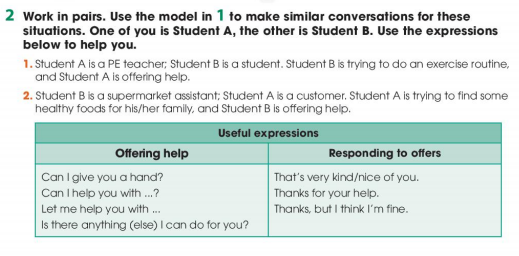
Gợi ý đáp án
1. A: Let me show you how to do squats properly.
B: Oh, please. I'm really struggling to do them.
A: No problem, let me show you. First, stand with your feet apart and your arms stretched in front of you. Then, bend your knees to lower yourself as far as possible. Next, return to the starting position. Let's do it again.
B: OK, like this?
A: Yes. Well done!
B: Thanks for your help.
2. B: Can I help you with anything, Madam?
A: Yes, please. I'm looking for some fresh spinach, but I can't see any.
B: I'm so sorry. We've sold out of fresh spinach, but you can still buy our frozen spinach leaves.
A: No, I'd rather cook with fresh vegetables. How about pak choi?
B: Oh, yes. You can find plenty of pak choi over there. Let me show you.
A: That's very kind of you.
B: You're welcome.
CLIL
1. Read the text and complete the comparison table below.
(Đọc đoạn văn và hoàn thành bảng so sánh dưới đây.)
BACTERIA AND VIRUSES
Both bacteria and viruses can cause diseases, but they are different in many ways. Bacteria are living organisms. They can live in many places, such as soil, water, and the human body. The smallest bacteria are about 0.4 micron* in diameter. Some bacteria in our bodies are helpful, but some can cause infectious diseases such as tuberculosis** or food poisoning. Antibiotics are often used to treat infections caused by bacteria.
*7 metre = 1 million microns
**a serious lung disease
Viruses are tiny germs that cause diseases in people, animals, and plants. They can cause a range of illnesses, from the common cold or the flu to more serious diseases such as AIDS and Covid-19. As they are very small (0.02 to 0.25 micron), viruses can get into our bodies easily. They are not living things, so they need to enter our bodies to become active. Then, they start to grow and cause the infected cell to make millions of copies of the virus. Vaccines are often used to prevent the spread of diseases caused by viruses.
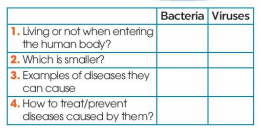
Gợi ý đáp án
Bacteria | Viruses | |
1. Living or not when entering the human body? | living | not living |
2. Which is smaller? | bigger | smaller |
3. Examples of diseases they can cause | tuberculosis or food poisoning | common cold or the flu to more serious diseases such as AIDS and Covid-19 |
4. How to treat/prevent diseases caused by them? | antibiotics | vaccines |
2. Discuss in pairs. What would you say to these people?
(Thảo luận theo nhóm đôi. Bạn sẽ nói gì với họ?)
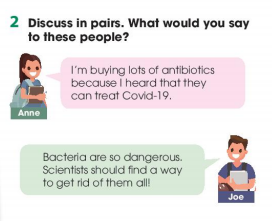
Gợi ý đáp án
To Anne: Covid 19 is caused by a new coronavirus. Antibiotics are useful for treating diseases caused by bacteria, not viruses. A better way to protect yourself from viruses in general and coronaviruses in particular is to get vaccinated.
To Joe: Not all bacteria are bad or dangerous. Some bacteria are useful for our body and nature, for example, some can help us to digest food or absorb nutrients, some can help to decompose rubbish in nature. Therefore, we should not try to get rid of them all.
Xem tiếp: Soạn tiếng Anh 11 Global Success Unit 1 Looking back MỚI
Trên đây là Soạn tiếng Anh 11 Global Success Unit 1 Communication and Culture/ CLIL đầy đủ nhất.



